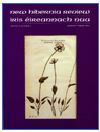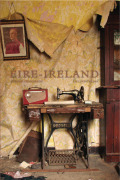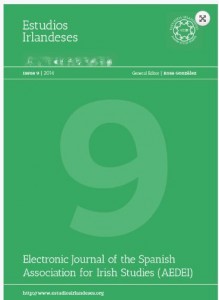New Issues of Journals
Posted on January 6, 2015 in Journals and Magazines
Issue 63 of the Dublin Review of Books has just come out.
Among the books reviewed are the following:
Periodicals and Journalism in Twentieth-Century Ireland, Mark O’Brien and Felix M. Larkin (eds), Four Courts Press.
Hesburgh Library status: In process.
Romancing Ireland: Richard Hayward 1892-1964, by Paul Clements. Lilliput, 2014.
Hesburgh Library: DA 963 .C54 2014
Captain Jack White: Imperialism, Anarchism and the Irish Citizen Army, by Leo Keohane, Merrion Press.
Hesburgh Library status: In process.
Ireland and the Irish in Interwar England, by Mo Moulton, Cambridge University Press.
Hesburgh Library: DA 125 .I7 M68 2014
Irish Studies journals with recent issues:
New Hibernia Review, Vol. 18, no. 4 Winter/Geimhreadh 2014
 Project Muse is our subscription service for this journal, and may be accessed via the Library:
Project Muse is our subscription service for this journal, and may be accessed via the Library:
The most recent issue includes the following:
Bob Quinn. Conamara Revolution.
Stephanie Rains. “Do you ring? Or are you rung for?” Mass media, class, and social aspiration in Edwardian Ireland.
Siobhán Campbell. Filíocht Nua: New Poetry.
Mark S. Quigley. Modernization’s lost pasts: Sean O’Faolain, the Bell, and Irish modernization before Lemass.
Tomás Ó h-Íde. Robert Flaherty’s Oidhche Sheanchais: The first film in Irish.
Wes Hamrick. The public sphere and eighteenth-century Ireland.
Ian O’Donnell, David M. Doyle. A family affair? English hangmen and a Dublin jail, 1923-54.
Christelle Serée-Chaussinand. Actaeon revisited: Seamus Heaney and Sinéad Morrissey respond to Titian.
Ellen Scheible. Imperialism, aesthetics, and Gothic confrontation in The Picture of Dorian Gray.
Éire-Ireland: Volume 49, Issues 3 & 4, Fall/Winter 2014.
 This journal also comes via a subscription to Project Muse, and so the articles may be found via the Library.
This journal also comes via a subscription to Project Muse, and so the articles may be found via the Library.
Contents of the current issue include the following:
Andy Bielenberg. “Something of the nature of a massacre”: The Bandon Valley Killings revisited. Andy Bielenberg, John Borgonovo, James S. Donnelly Jr.
Elizabeth Cullingford. American dreams: Emigration or exile in contemporary Irish fiction?
Ellen McWilliams. “No place is home– It is as it should be”: Exile in the writing of Maeve Brennan.
Darragh Gannon. The rise of the Rainbow Chasers: Advanced Irish political nationalism in Britain, 1916-22.
Mel Farrell. From Cumann na nGaedheal to Fine Gael: The foundation of the United Ireland party in September 1933.
Nicholas M. Wolf. Introduction: Mathew Carey and Dublin. Nicholas M. Wolf and Benjamin Bankhurst.
Padhraig Higgins. Mathew Carey, Catholic identity, and the Penal Laws.
James Kelly. Mathew Carey’s Irish apprenticeship: Editing the Volunteers Journal, 1783-84.
Nicholas M. Wolf. Advocacy, the Enlightenment, and the Catholic print trade in Mathew Carey’s dublin.
Ronald Schuchard. “Into the heartland of the ordinary”: Seamus Heaney, Thomas Hardy, and the dividied traditions of modern and contemporary poetry.
Terence Brown. Seamus Heaney’s tender Yeats.
Stephen Regan. “Things remembered”: Objects of memory in the poetry of Seamus Heaney.
Estudios Irlandeses, Issue 9 (2014)
 Estudios Irlandeses, the peer-reviewd, open source electronic journal of the Spanish Association for Irish Studies, is published online in March, so this issue is not quite so recent.
Estudios Irlandeses, the peer-reviewd, open source electronic journal of the Spanish Association for Irish Studies, is published online in March, so this issue is not quite so recent.
Among the articles, essays, interviews and translations in Issue 9 are the following:
Mercedes del Campo del Pozo. “Mother Ireland, get off our backs”: Gender, Republicanism and state politics in prison short stories by Northern Irish women writers.
Claire A. Culleton. Competing concepts of culture: Irish art at the 1924 Paris Olympic Games.
Juan F. Elices. Uchronian scenarios in the context of Irish literature: The case of C. B. Gilford’s The Crooked Shamrock.
Bill Gray. “A thrilling beauty”? Violence, transcendence and the Shankill Butchers in Eoin McNamee’s Resurrection Man.
José M. Yebra. The interstitial status of Irish gayness in Colm Tóibín’s The Blackwater Lightship and The Master.







